
Retaining Walls
Learn how to get the best retaining wall results for your property.
This page will describe the different types of common retaining solutions to properties. Learn about the different types of retaining walls.
If you have no experience in the construction and engineering of retaining walls and would like to learn more then this page is for you.
If the retaining wall near your property is falling over then find out what to do here.
Three of the most common retaining wall types to private properties are:
The retaining wall is moving and cracking. What do I do?
Why do I need a retaining wall?
It is easier for people to walk around on a flat area of property. Are you looking to lay pavers, turf or extend the usable land.
If you have a sloping site and you want a flat area then you will require a retaining wall.
Cutting or filling a volume of earth to create a level pad area will result in a steep embankment. The height of the steep embankment will depend on the existing slope to the site and the width of level pad area required.

You can build retaining walls because it provides flatter ground.
Sure, you could attempt to just leave the steep embankment unretained. What’s the worst that could happen? The steep unretained embankment can fail catastrophically. Property damage, injury and death can occur from unretained embankment failure.
Contact the engineer to assist with planning the best solution for a level pad area to your property.
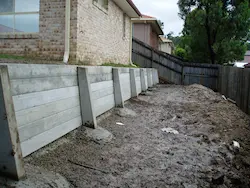
Post and Sleeper Retaining Wall
A post and sleeper retaining wall is a very common solution.
Post and sleeper walls are economical. But they are not suitable for shallow rock sites.
Posts
This retaining wall is shown to be constructed with vertical posts. Typical materials used for post construction include treated hardwood timber, galvanised steel or precast concrete posts. It is not advisable to use treated pine posts.
Sleepers
Horizontal sleepers are supported by posts to retain a drainage layer and the embankment. The sleepers are constructed with the use of treated timber and precast concrete sleepers.
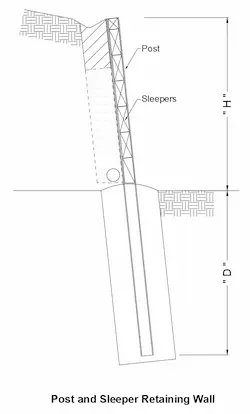
Caution
Posts need to be founded to an adeqaute depth in the ground. Post and sleeper walls are not recommended where shallow rock foundation conditions exist. Obtain a soil test to the site to confirm the foundation conditions prior to obtaining an engineering design and engaging a contractor to commence construction of the wall.
Clay or sand foundation conditions of sufficient depth area required to a site for a post and sleeper wall solution. If shallow rock is present under the surface then a post and sleeper wall solution will not work. Shallow rock will prevent excavtion to the required depth.
Obtain an engineering design solution for a retaining wall. It is more economical than you think.
Contact the engineer to discuss the best retaining wall solution for your site and to obtain a quote.
Construct an engineered retaining wall. It is far more economical to build it right the first time rather than having to remove a failed wall and then reconstruct. Failure of inadequate retaining structures is extremely common and provides the risk of property damage, injury and death to property users.

Cantilever Blockwork Retaining Wall
Obtain an engineer design for a cantilever blockwork wall for your property.
A concrete blockwork retaining wall is an ideal solution for a variety of foundation conditions including where shallow rock is present to a site.
You can finish the face of the concrete blockwork wall with render and painting for a and painted to provide you with a fantastic aesthetic finish.
Whenever you are looking to save room on your property and have a great aesthetic finish — the concrete blockwork retaining wall is worth considering.
The engineering to your concrete footing system should conceal it from view.
This means that the property owner can benefit from landscape finishes to the areas above and below the wall with minimal visual impact to the property.
A well constructed and maintained cantilever blockwork wall is very durable and should be providing an economic life-cycle in excess of 50 years.
You should build a wall that will last.
Trying to re-build a failing wall is a cost you don’t need. Also, trying to get access back to a finished wall may not be possible.
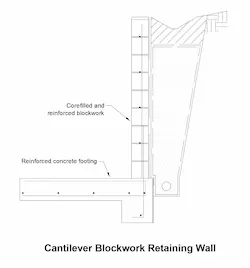
A cantilever wall is constructed with the use of a reinforced concrete footing. The blockwork wall is then constructed vertically on the footing, reinforced and filled with concrete. An adequate drainage layer is required to be provided between the wall and the retained earth material. An adequate drainage layer is essential to prevent the buildup of hydrostatic pressures behind the wall.
A property owner should be aware that engineering advice is essential to retaining walls. It is required to obtain an engineering design and inspections to a cantilever blockwork wall.
Contact the engineer to obtain the required design and inspections prior to commencing work.
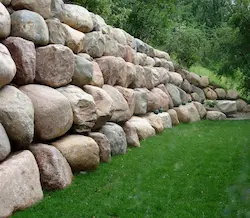
Boulder Retaining Wall
Boulder retaining wall – Buyer beware.
Basically, anyone can build a Boulder wall by trying to stack rocks against an earth cut face.
An adequately designed and constructed boulder wall relies on the mass of the boulders to act against the earth retained face. It is essential that an adequate incline be provided to the face of the boulder wall so that there is a horizontal component from the force of gravity acting on the mass of the wall.
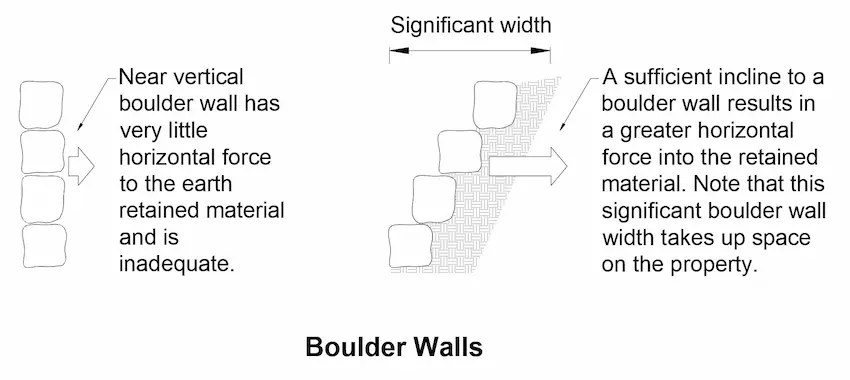
The boulder wall constructed near vertical does not has enough mass ‘leaning in’ to the earth material that is reliant on support.
Inadequate construction to boulder walls is a common problem.
While they are relatively economical, boulder walls take up a lot of space on the property. You will require a significant width to the boulder wall to achieve a sufficient incline which takes up space on the property.
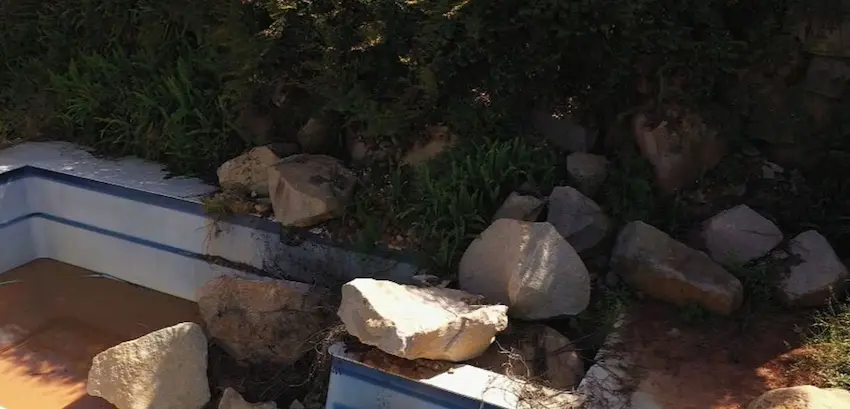
You might have a boulder wall that your Builder constructed a bit too vertical to save space. If you have a boulder wall that is too vertical, it could be at risk of catastrophic failure. This results in construction of an inadequate retaining wall. There are also other significant factors to inadequate boulder walls such as a lack of adequate footing support, amongst other things.
Inadequate construction to a boulder wall provides the hazard of catastrophic failure resulting in property damage, injury or death to property users.
In our professional experience, we have observed a high rate of inadequate construction to attempted boulder walls. The fact that the wall has been present to the site for a period of time provides no assurance to its ongoing performance.
We do not provide structural design to boulder walls.
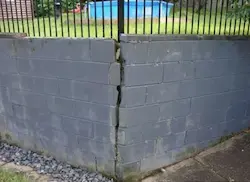
Retaining Wall Movement and Cracking
The retaining wall movement movement and cracking could be a sign of impending failure. Arrange an engineer inspection.
Do you have a retaining wall that looks to be moving, cracking or leaning over. Need to know what to do?
The answer is to get a structural engineer out to site to inspect and advise.
My Clients benefit from obtaining independent engineering advice, because you will know what has gone wrong, what you need to do and how to achieve the repair or replacement of the wall.
The problem with retaining structures that show signs of movement and cracking is that they may be showing signs of catastrophic failure about to occur.
I consider many factors in relation to your reported retaining wall movement and cracking.
Contact the engineer to obtain advice in relation to the retaining wall you are concerned with.
